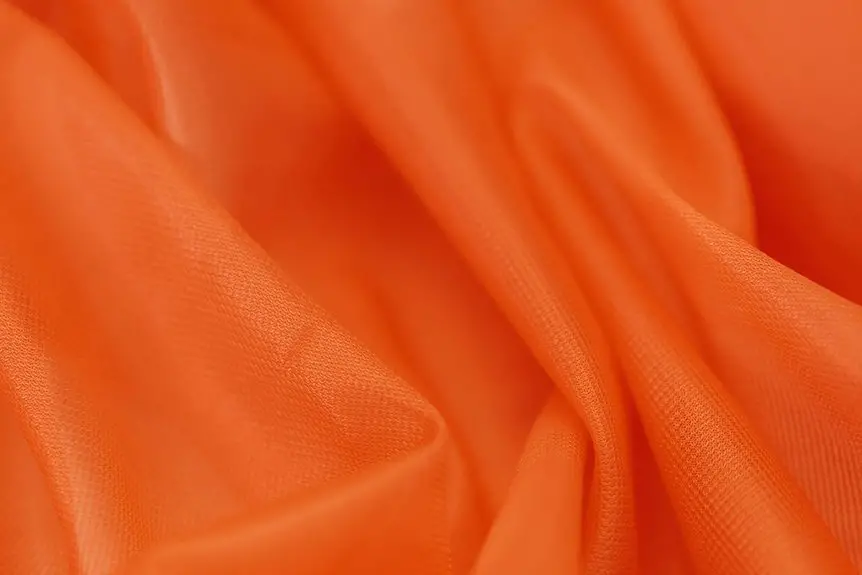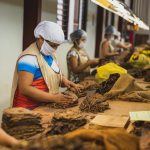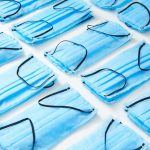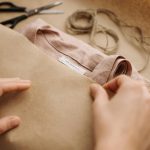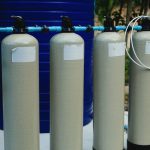Nonwoven filter fabric is a lightweight, durable material made by bonding fibers without weaving or knitting. You’ll find it traps particles effectively, allowing air or liquids to pass while catching contaminants. Made from materials like polypropylene or polyester, it’s used in face masks, HVAC filters, and more. Its types include spunbond and meltblown, each suited for different filtration needs. If you want to understand how it works and its benefits, keep exploring further details.
Table of Contents
Key Takeaways
- Nonwoven filter fabric is a porous material designed to trap particles without woven or knitted structures.
- It is made by bonding fibers mechanically, thermally, or chemically for durability and filtration efficiency.
- Common materials include polypropylene, polyester, nylon, and rayon, tailored for specific filtration needs.
- Types include spunbond, meltblown, needle-punched, and wet-laid, each serving different filtration purposes.
- It is lightweight, resistant to tearing and chemicals, and widely used in air and liquid filtration applications.
Definition and Characteristics of Nonwoven Filter Fabric
Nonwoven filter fabric is a versatile material designed to trap particles and contaminants efficiently. When you use this fabric, you’ll notice it doesn’t have a woven or knitted structure. Instead, it’s made by bonding fibers together through mechanical, thermal, or chemical means.
This unique construction gives it excellent filtration properties. You’ll find it lightweight, durable, and resistant to tearing, which makes it ideal for various filtration applications.
Because it’s porous, it allows air or liquid to pass while capturing unwanted particles. Plus, its thickness and fiber arrangement can be customized to target specific particle sizes.
Materials Used in Nonwoven Filter Fabric Production
Choosing the right materials plays an essential role in how well filter fabric performs. When you select materials, you need to take into account factors like durability, filtration efficiency, and resistance to chemicals or moisture.
Selecting materials carefully ensures filter fabric delivers durability, efficiency, and resistance to chemicals and moisture.
Nonwoven filter fabrics commonly use synthetic fibers because they offer consistent quality and strong filtration properties.
Here are some key materials used in nonwoven filter fabric production:
- Polypropylene: Lightweight, chemically resistant, and cost-effective.
- Polyester: Strong, durable, and handles moisture well.
- Nylon: Offers excellent abrasion resistance and strength.
- Rayon: Provides good filtration with natural absorbency.
Each material brings unique benefits, so your choice will depend on the specific filtration needs and environmental conditions your filter fabric must withstand.
Manufacturing Processes of Nonwoven Filter Fabrics
The materials you select set the foundation, but how those fibers come together defines the fabric’s final performance.
You’ll typically use one of several manufacturing processes: dry laid, wet laid, or spunbond. In dry laid, fibers are carded and laid into a web, then bonded by heat, chemicals, or mechanical means.
Wet laid mimics paper-making, suspending fibers in water before forming them into a web, ideal for fine filtration.
Spunbond involves extruding molten polymer filaments directly into a web, creating strong, continuous fibers.
After web formation, you bond the fibers to add strength and stability—methods include thermal bonding, needle punching, or chemical bonding.
Each step impacts filtration efficiency, durability, and breathability, so choosing the right process guarantees your nonwoven filter fabric meets your specific needs.
Types of Nonwoven Filter Fabrics
You’ll find several types of filter fabrics, each designed to tackle specific filtration challenges.
When choosing the right nonwoven filter fabric, consider the material, structure, and application needs.
Here are four common types you’ll encounter:
- Spunbond: Durable and strong, ideal for coarse filtration and support layers.
- Meltblown: Features fine fibers, perfect for capturing tiny particles and contaminants.
- Needle-punched: Mechanically entangled fibers provide thickness and filtration for air and liquid.
- Wet-laid: Offers uniformity and fine filtration, often used in medical and hygiene products.
Understanding these types helps you select the best fabric to meet your filtration requirements effectively without compromising performance or cost.
Filtration Mechanisms in Nonwoven Fabrics
Each type of nonwoven filter fabric employs specific mechanisms to trap particles, influencing its effectiveness in various applications.
When you use these fabrics, you rely on processes like interception, where particles follow airflow and get caught as they touch fibers.
Inertial impaction helps capture larger particles that can’t follow airflow changes and collide with fibers.
Diffusion targets smaller particles, which move erratically and eventually hit fibers by chance.
Electrostatic attraction adds another layer by pulling particles to charged fibers, enhancing filtration without increasing resistance.
You’ll find that combining these mechanisms allows nonwoven fabrics to filter a wide range of particle sizes efficiently, making them versatile for everything from air purification to liquid filtration.
Understanding these mechanisms helps you choose the right fabric for your needs.
Common Applications of Nonwoven Filter Fabrics
You’ll find nonwoven filter fabrics everywhere, especially in air filtration systems that keep your environment clean and safe.
They also excel at filtering liquids, providing reliable protection in various industrial and medical settings.
Let’s explore how these fabrics make a difference in both air and liquid filtration.
Air Filtration Uses
Air filtration systems rely heavily on nonwoven filter fabrics to trap dust, pollen, and other airborne particles effectively.
When you use these fabrics, you improve air quality in homes, workplaces, and public spaces by capturing pollutants that cause allergies and respiratory issues. Their durability and efficiency make them ideal for various air filtration needs.
You’ll find nonwoven filter fabrics used in:
- HVAC systems for clean indoor air
- Automotive cabin filters to protect passengers
- Face masks and respirators for personal safety
- Air purifiers that enhance breathing comfort
Liquid Filtration Benefits
While liquid filtration might seem less visible than air filtration, nonwoven filter fabrics play an essential role in keeping liquids clean and safe. When you use these fabrics, you benefit from their excellent ability to trap contaminants like sediments, bacteria, and oils without slowing down flow rates.
Whether you’re filtering water, beverages, or industrial liquids, nonwoven fabrics provide consistent performance and durability. They resist clogging and handle varying liquid viscosities, so maintenance is easier and downtime is reduced.
Plus, their customizable fiber sizes let you tailor filtration levels to your specific needs. By choosing nonwoven filter fabrics, you guarantee efficient purification, protect downstream equipment, and meet regulatory standards more reliably. They’re a smart choice for liquid filtration in many industries.
Advantages Over Woven and Knitted Fabrics
You’ll find that nonwoven filter fabrics offer enhanced filtration efficiency compared to woven and knitted options.
They also provide superior durability and strength while remaining lightweight.
Plus, they’re often more cost-effective, making them a smart choice for many applications.
Enhanced Filtration Efficiency
Because nonwoven filter fabrics have a unique structure, they trap particles more effectively than woven or knitted fabrics. When you use nonwoven fabrics, you benefit from their randomly oriented fibers, which create a dense, multi-layered network. This design captures contaminants of various sizes more efficiently, making your filtration system more reliable.
Unlike woven or knitted fabrics, nonwovens offer better airflow while maintaining superior particle retention. This means you get cleaner air or liquid without sacrificing performance.
Here’s why nonwoven filter fabrics enhance filtration efficiency:
- Random fiber arrangement traps particles more effectively
- Multiple layers increase filtration depth
- Higher porosity balances airflow and filtration
- Ability to capture both large and microscopic particles
This makes nonwoven fabrics your best choice for advanced filtration needs.
Superior Durability and Strength
When you choose nonwoven filter fabrics, you get materials designed to withstand tough conditions without losing their integrity. Unlike woven or knitted fabrics, nonwovens resist tearing and maintain strength even under heavy use or exposure to chemicals and moisture. This durability means your filters last longer and perform consistently. Here’s a quick comparison to help you see why nonwovens stand out:
| Feature | Nonwoven Fabrics | Woven Fabrics |
|---|---|---|
| Tear Resistance | High | Moderate |
| Chemical Resistance | Excellent | Variable |
| Moisture Absorption | Low | Higher |
| Strength Retention | Maintains under stress | Can weaken over time |
| Longevity | Extended use possible | Generally shorter |
Lightweight and Cost-Effective
Although nonwoven filter fabrics offer exceptional durability, they also excel in being lightweight and cost-effective.
When you choose nonwoven materials, you benefit from easier handling and reduced shipping costs due to their lighter weight.
Plus, the manufacturing process uses less energy and fewer raw materials, which keeps prices low without sacrificing performance.
Compared to woven and knitted fabrics, nonwovens give you more value for your money, especially in large-scale applications.
Here’s what makes them stand out:
- Lower production costs due to simpler manufacturing
- Reduced transportation expenses thanks to lighter weight
- Easier installation and maintenance because of flexible structure
- Efficient use of materials leading to less waste and better sustainability
These advantages make nonwoven filter fabrics a smart, economical choice.
Environmental Impact and Sustainability Considerations
Considering the growing focus on eco-friendly materials, you need to understand how nonwoven filter fabrics impact the environment. These fabrics often rely on synthetic polymers like polypropylene, which come from non-renewable petroleum sources.
However, many manufacturers now prioritize recyclable materials and incorporate bio-based fibers to reduce carbon footprints. When disposing of nonwoven filters, you should be aware that some types are biodegradable, while others require specialized recycling processes.
Many manufacturers now use recyclable and bio-based fibers, with some filters being biodegradable and others needing special recycling.
By choosing nonwoven fabrics designed for recyclability or biodegradability, you can help minimize landfill waste. Additionally, their lightweight nature reduces transportation emissions, making them a more sustainable option compared to heavier alternatives.
Being mindful of these factors allows you to select nonwoven filter fabrics that balance performance with environmental responsibility.
Future Trends in Nonwoven Filter Fabric Technology
As you explore advancements in nonwoven filter fabric technology, you’ll find innovations focused on enhancing filtration efficiency, durability, and sustainability.
You’ll see the integration of smart materials that adapt to environmental conditions, improving performance without sacrificing energy use. Biodegradable fibers are becoming more common, reducing waste and environmental footprint.
Additionally, manufacturers are adopting nanotechnology to create finer pores for capturing smaller particles, which boosts air and water purification. Automation in production processes also guarantees more consistent quality and scalability.
Key trends you should watch include:
- Smart, responsive filter materials
- Use of biodegradable and renewable fibers
- Nanofiber technology for superior filtration
- Automation and AI-driven manufacturing
These advancements will shape how effectively and sustainably nonwoven filters perform in the future.
Frequently Asked Questions
How Do Nonwoven Filter Fabrics Compare in Cost to Traditional Filters?
You’ll find nonwoven filter fabrics often cost less upfront than traditional filters. They’re lightweight and efficient, reducing replacement frequency and maintenance expenses, so overall, you might save money while enjoying effective filtration performance.
Can Nonwoven Filter Fabrics Be Cleaned and Reused?
Imagine you’re using a nonwoven air filter at home; yes, you can clean and reuse it gently by vacuuming or rinsing, but overdoing it might reduce effectiveness. So, handle with care to extend its life.
What Industries Are Investing Most in Nonwoven Filter Fabric Technology?
You’ll find industries like automotive, healthcare, and water treatment investing heavily in nonwoven filter fabric technology. They’re driving innovation to enhance filtration efficiency, durability, and sustainability for better performance in critical applications.
Are There Health Risks Associated With Handling Nonwoven Filter Fabrics?
You might face minor irritation or respiratory issues if fibers become airborne while handling nonwoven filter fabrics. Wearing protective gear like masks and gloves helps minimize health risks and keeps you safe during use or manufacturing.
How Long Do Nonwoven Filter Fabrics Typically Last in Industrial Use?
You probably expect nonwoven filter fabrics to last forever, but they typically last anywhere from six months to a few years in industrial use, depending on conditions and maintenance. Don’t forget to check them regularly!
- Nonwoven Fabric in the Furniture and Bedding Industry - July 11, 2025
- What Is PET Spunbond Nonwoven Fabric? - July 11, 2025
- How to Test the Quality of a Nonwoven Fabric - July 11, 2025

